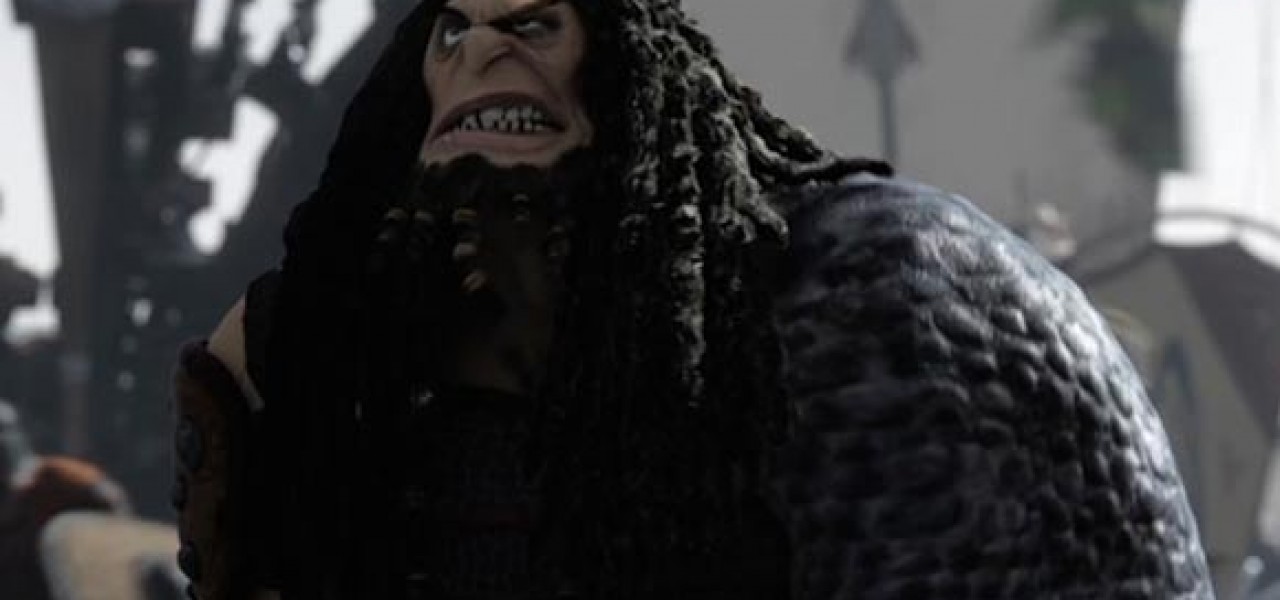
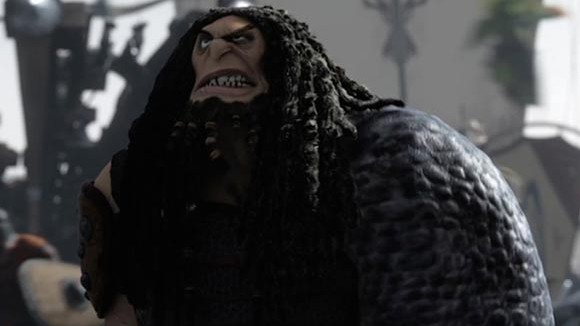
Oscar Ballot Guide: ‘How To Train Your Dragon 2’ Acting and Performance Analysis
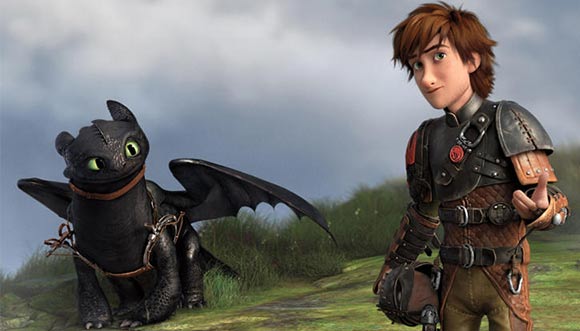
Part two of a five-part series in which Ed Hooks, author of Acting for Animators, does an acting and performance analysis of this year’s five Academy Award-nominated animated features.
Read his analysis of The Tale of The Princess Kaguya.
A talented actor can make even the most poorly written dialogue sound credible. The idea is to come up with a good and credible reason for saying and doing whatever the script requires you to say and do, an objective. The script for How to Train Your Dragon 2, written by Dean DeBlois who also directed, is too often over-written, full of expository wordy monologues and general filler. It presents its cast of characters with many challenges and, unfortunately, not all of them are up to the job.
Cate Blanchett (Valka) is a good actor—world class, actually—and therefore her dialogue scenes seem credible even when, on the page, they are not. Jay Baruchel (Hiccup), on the other hand, displays a narrow acting range, which makes his dialogue often seem even sillier than it already is. Gerard Butler (Stoick) is a talented actor, but is saddled with a one-dimensional stereotype character and rarely has much to work with. The courtship sequences he has with Cate Blanchett are lovely, the best acted in the film. Significantly, those scenes also have the least dialogue. Djimon Hounsou, voicing the villain, Drago, never has a chance to do much acting because his character is a one-note baddie, an underdeveloped growling menace designed for grade-school children.
Let’s look at a few specific sequences, to examine how actor, script, and animation performance are functioning together. The time-code is from the iTunes download.

10:16 – 13:09 This is the first scene between Hiccup (Jay Baruchel) and his girlfriend Astrid (America Ferrera). The set-up is that she wants to know why he didn’t participate in the Berk Village dragon races earlier that day. He says he’s been “avoiding my dad.” Astrid: “Oh no, what happened now?” Rather than answer the question directly, Hiccup begins a game of impersonations.
“You’re going to love this,” he explains. “ I wake up; the sun is shining, Terrible Terrors are singing on the rooftop. I saunter down to breakfast thinking all is right with the world, and I get… (he rises now to his feet and starts strutting around, doing a purposely corny impersonation of his father, Stoick) ‘Son (heavy fake Scottish accent), we need to talk.’”
Hiccup’s impersonation of Stoick amuses Astrid so much that she joins in with her own extreme nasal, over-physicalized, over-the-top impersonation of Hiccup. At this point in their conversation, her question about what happened with his father that morning has been tossed into the back seat while the two of them clown around like adorable goofballs. The sequence goes on like this, with Hiccup imitating Stoick, until he imitates the part where Stoick told Hiccup that he would one day become Viking chief. Then Astrid excitedly tries to get him back on topic: “Oh my God, Hiccup, that’s amazing!” And she punches him in the chest with her fist.
We are almost two minutes into the Hiccup/Astrid scene before it gets to the point. Finally, it emerges that Stoick has formally christened Hiccup as his successor and, rather than respond to the honor like the twenty-year old adult that he presumably is, Hiccup ran wordlessly away. That is what brought him to this location where Astrid finds him.
Acting principle: Acting has almost nothing to do with words. In general, when it comes to screenplays, the leaner the dialogue, the better. Stage plays are about words; movies are about moving.
Another sequence, illustrating the challenge faced by the actors in this film: 14:11 – 16:49 Astrid’s dragon, Stormfly, has been captured by Eret’s men, and Astrid was almost killed in the process. Illogically, Astrid and Hiccup storm the fort, the two of them up against a band of thugs. Realizing the danger finally, Hiccup says, “Look, we don’t want any trouble.” That is an asinine line. What, other than trouble, would one expect if one’s dragon had been violently snatched out of the air and the heroine almost dies?
A stronger actor than Mr. Baruchel might have delivered the line in a self-effacing, attempted-humorous fashion, the intention being to defuse the situation. But poor Mr. Baruchel delivers it straight, which makes him seem like even more of a ninny. The way he handles this encounter makes you wonder what Stoick had been drinking when he named the kid his successor.
That’s not the worst of it in this section. Eret (Kit Harington), the dragon thief, proceeds to lecture Hiccup and Astrid about his personal business, including his relationship with Drago, the villain. Acting-wise, there is no reason at all for Eret to dump all of this on Hiccup and Astrid. It is included in the script in order to provide exposition for the movie’s audience, which is the worst possible reason to include dialogue in a script. Mr. Harington understandably can do nothing with the monologue other than to say the words. Acting-wise, Eret appears not to have a motivation other than to hear himself talk.
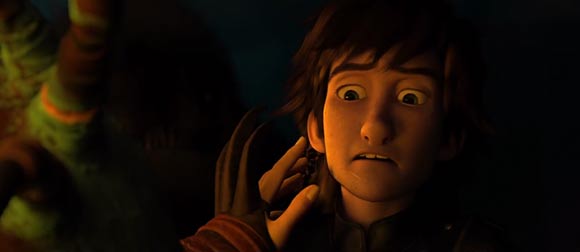
Let’s fast-forward to the first scene in which Hiccup and his mother, Valka (Cate Blanchett), interact, 30:45 – 32:29, so we have something positive to talk about: Valka, covered from head to toe in her costume, has captured Toothless and Hiccup without realizing that the young man is the son she has not seen since he was an infant. The scene requires Valka to reach out and touch Hiccup’s cheek, discovering his identifying chin scar. Think about the acting required for that moment: What possible motivation would this woman have to touch this young man’s cheek? She doesn’t know who he is, right? She has literally knocked him out of the sky and taken him prisoner. Touching his cheek is just about the last thing Valka might want to do. The only reason cheek-touching is included is to set up the upcoming expositional monologue which will explain how he came to get the scar in the first place.
Acting-wise, it is a tough moment for Ms. Blanchett. Being the kind of actor she is, though, she chose to go primal with the moment, almost animalistic, pre-human. Not having seen the videotaped references from Blanchett’s recording session, I cannot say with complete certainty that she authored the physicalization in this sequence but it “feels” to me that is the case. My bet is that to justify the moment, she paused in recording, reached out to touch Hiccup’s cheek and then proceeded, a gesture that found its way into the film. If the animator authored the gesture without a specific reference, like Blanchett or the mo-cap actors, my hat is off to them, with apologies. Valka reaches out tentatively, like she has not recently been this close to a human, like she is herself more dinosaur than human. It is a brilliant acting choice. Blanchett—or perhaps the animator—motivates an action that, in itself, makes no sense whatever. Once she touches and recognizes his chin scar, she reacts strongly.
Acting note: Acting is RE-acting. Non-verbally. Hiccup says, in reaction to her reaction, “Do I know you?” “No,” she replies. Beat. Breathe. “You were only a babe…” Beat. Breathe. “…but a…mother … never forgets.” World class acting here. Cate Blanchett is so marvelously talented that she pulls Jay Baruchel up by his bootstraps. Another acting note: It is almost impossible to be a bad actor if you are acting with a good actor. Robert DeNiro, for example, has never had a weak acting partner.
How to Train Your Dragon 2 is the second installment in a previously-announced trilogy and, as such, writer-director Dean DeBlois faced many challenges. The toughest one was the self-imposed necessity to catch up to date any viewers who might have missed seeing the first film.
Ideally, this second installment would stand alone without such expositional catching up. Toy Story 2 stands alone, for example, as do each of the films in the Star Wars series. The audience should be able to glean sufficient back-story through inference based upon the present-moment actions of the characters. Dragon, though, is overloaded with exposition, and too much of the plot progression depends upon coincidence. How, for example, do Stoick and Gobber manage to discover Hiccup’s little helmet floating in the icy ocean expanse? (32:40) In general, coincidence is a tricky plot-development screenwriting device. (See Story – Substance, Structure, Style, and the Principles of Screenwriting, by Robert McKee, page 357: “Coincidence, therefore, must not pop into a story, turn a scene, then pop out.”)
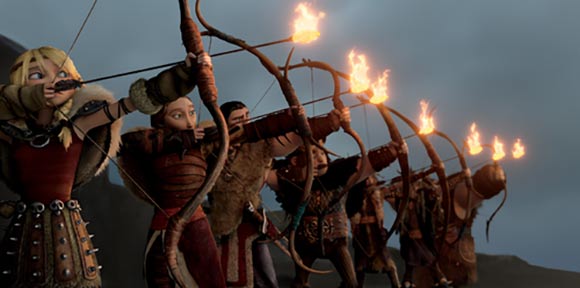
There are several legitimately moving sequences in this film, and they work primarily because they are classic shamanistic moments. The courtship dance and lullaby scenes (56:17 – 1:00:37) featuring Stoick and Valka are worth the price of admission. They are magical, moving, cleanly written and sensitively acted. Stoick’s funeral pyre (1:14:03 – 1:18:35) will make you cry, so full of emotion and ritual. Significantly and this really cannot be overemphasized, the best moments in Dragon 2 are non-verbal. The movie works best when the screenwriter Mr. DeBlois gets out of the way and lets Mr. DeBlois, the director, do his job.
A few words about Drago, the antagonist in this story. Unfortunately, the character is not at all empathetic, coming off in shades of black. His strongest scene is when he displays his arm stump (1:08:10 – 1:10:32), identifying him as a kind of Captain Ahab-esque character, but with none of the literary nuance. There is a missed opportunity at 1:11:15, after Toothless kills Stoick. As it is, Drago dismissively shrugs at all the carnage and blithely walks away. If only he had paused for two or three seconds, taking in the scene, letting it register mentally that this just might be awful. Let us see him recognize the stakes, have at least a shred of regret, and still turn away.
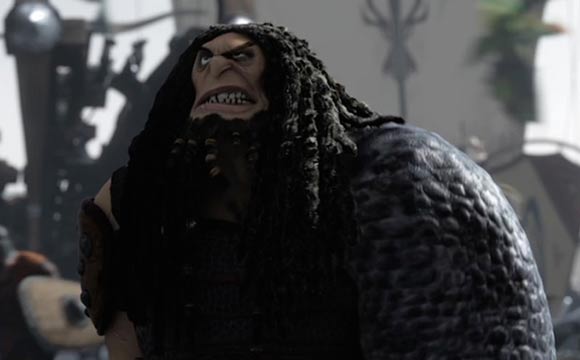
The moment was an opportunity for Drago to evoke a sliver of empathy in the audience. In the real adult world, evil people do not think they are evil; every human is a hero in his or her own life. Drago’s characterization cements this entire film as a movie for kids. Cate Blanchett’s work comes close to dragging the whole thing into a more mature category, but she can’t do it by herself.
Overall, How to Train Your Dragon 2 is more an example of artisanship than artistry. The character design for the dragons, all umpteen thousand of them, is drop-dead wonderful. The animation simply can’t be beat. DreamWorks is home to the best of the best in that department. If awards were given on animation craft alone, it would be hard to beat this. What’s lacking is script. Hiccup, the protagonist, is presented as a wuss and follows a convoluted character arc. The story would have worked better if Hiccup were not so aimless at the top. This being a trilogy, they will have another chance to get it right.
ED HOOKS is the author of Acting for Animators, (revised third edition, Routledge, 2011). Ed pioneered Acting for Animators in 1998 while working with the animators at PDI/DreamWorks in northern California, and teaches the Acting for Animators masterclass internationally. For Cartoon Brew, he previously wrote a performance analysis of Disney’s Frozen. For more information about his practice, visit EdHooks.com
